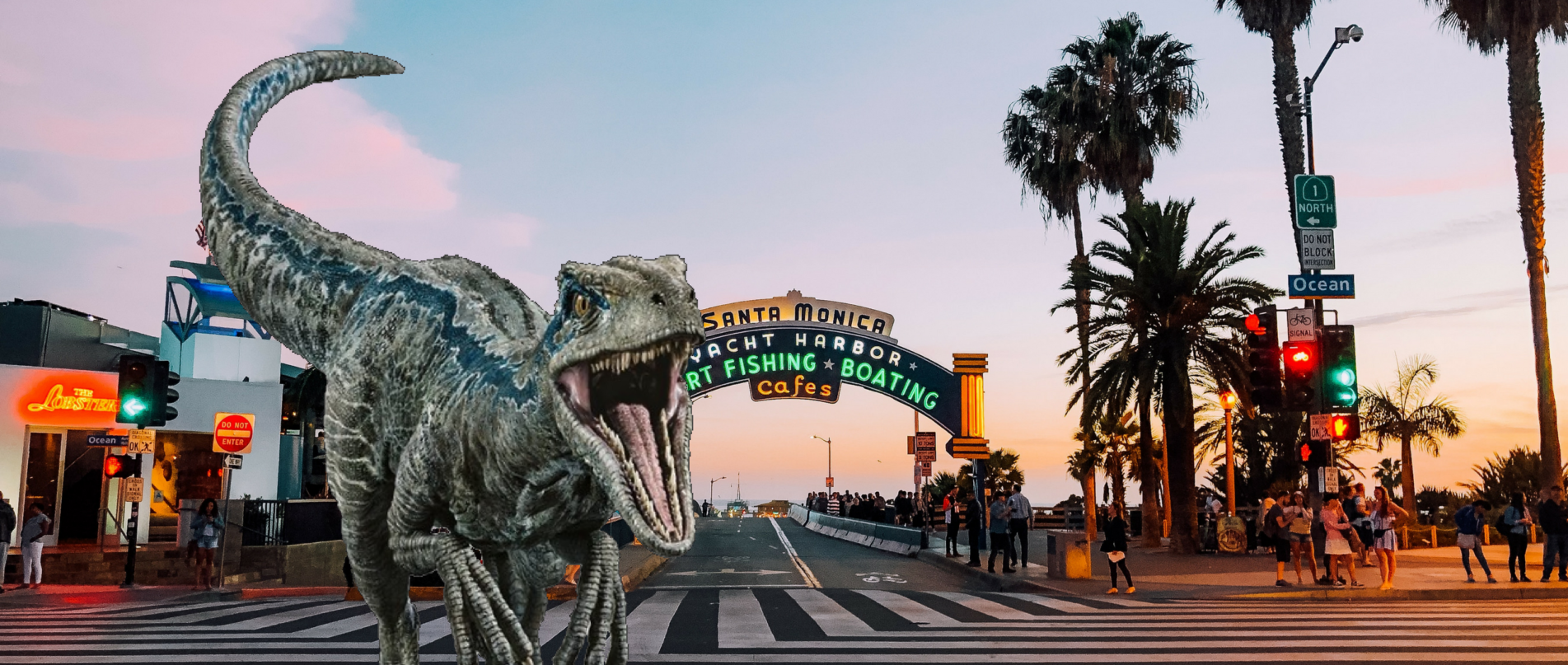
Prompt Images
Blue the Raptor, wearing sunglasses and a high-neck, sleeveless swimsuit, lounged under an overlarge cabana at the beach between two muscular but withered men who stood waiting for her to move. But she moved not a muscle. For hours she laid in her shade, flexing the figure of a supermodel or a superhero. Anyone who stared long enough might wonder if she could be both.
She had been still for much of the day, settling into a cool spot in the beach like a cat that’s found a pool of sunshine to rest in. The men who had paved her way, protecting her from leering fans—or, if she was hungry, vice versa—shifted their stances inward through the cabana, over her body rising with breaths, through the shade, and into the sand and sunshine of the wide beaches where hundreds of families lay over colorful towels and half-formed sandcastles or splashed their friends with the surf of a crashing wave.
The noises of fun and joy that are common at every California beach in the summer were no less common here, with a raptor in their midst. The two men knew, as did Blue’s security team, stationed in four black Escalades along the boardwalk, that the excitement of a family outing could turn to blood and disaster if they didn’t pinpoint her movement early enough to deploy the tranquilizers. A drone whirred at the edge of the cabana, a layer of extra security, sending motion detection and early warning indicators back to her security team and the compound at Universal Studios.
“In all of human history, not one person has been killed by a dinosaur.”
It’s hard to separate the person, Blue the Raptor, from the action-hero. Despite the carefree attitude of beach visitors that day, the raptor’s appearance in public has been met in the past by screams and fear. A public appearance after the 2015 opening of Jurassic World sparked a stampede along the boardwalk when she descended from her trailer on a Saturday afternoon. Thirty-one people were hospitalized, seven of them with severe injuries.
None of them died that day. And none of them was attacked by a raptor. That’s the part her publicist insisted I include.
“It’s something that weighs heavy on her mind,” Jim Hayes, Blue’s publicist, tells me when I follow up to schedule an interview.
Since the stampede three years ago, her team has made sure to publicize all her movements on social media. They’ve worked with the City of Santa Monica and the Fire Department to educate visitors on raptor safety, emergency protocol, and to display her visiting schedule on large placards at the top of the beach.
A prey of photographers clustered on the ridge of the beach before the boardwalk. Their lenses pointed at Blue’s cabana, hoping for more than her arrival and departure. Maybe a better look at the swimsuit; maybe a small smile; maybe a new color on her arching two toenails. Deep down we all know they wanted a gore show, but none of them admitted the desire, an unlikely event born more from the success of violent dinosaur movies than reality.
“In all of human history, not one person has been killed by a dinosaur,” Hayes reminds me.
I scribble the stat on a scrap of paper, some junk mail I’d never opened. It’s the kind of fact that politicians hurl at a friendly crowd to reinforce their enthusiasm for a candidate that’s bound to disappoint them once in power. I call Hailey, my fact-checker. Her voice snaps with the precision of a ring binder closing securely with well-referenced information. She’s a raptor fan and exhumes excitement when I tell her my request.
“He’s right,” she swoons. To the point. “Not even an accidental death.”
For Jim Hayes, Hailey Bishop, Universal Studios, raptor fans, my 5-year-old godson, and, of course, Blue the Raptor herself: no human has ever been killed by a dinosaur.
But they are fucking scary.
The living room vibrated with the color blue. The wall-to-wall carpet was an ocean. Sky, midnight, royal, cadet, and turquoise blue dotted across the walls like a broad pointalist portrait, the pattern hidden unless observed from miles away. Standing in the room, I was too close to discover it.
The stereo sang a melody I recognized as “Blue in Green” from Miles Davis’s Kind of Blue. I wish the air had a fragrance that could be listed as a color, but sadly it only smelled of lavender from a candle that had been put away before I arrived.
“Only you would point out all these connections and try to make something of it,” Blue tells me later when I ask her about the motif. “The apartment came this way when I moved in at the beginning of the year. I just haven’t gotten around to changing it.”
And the music? “Miles is the best!”
Her voice nearly roars with excitement. Nearly.
“You’d probably say I was interested in experimentation if I had Bitches Brew on or that I was exploring my roots if I played Sketches of Spain.”
When I arrived at her apartment, the blonde who answered the door offered me a seat in one of the throw pillows scattered around the otherwise empty living room floor. “She’ll be with you shortly.” The cushions were shades of brown.
I listened for the raptor’s approach, conscious that I’m sitting prey, a course serve fresh, lounging in her apartment. I kept my eyes tight on the only doors into this room, not that seeing my attacker would help. I was defenseless and without a weapon.
Blue had been sick for the past month. She’d been suffering from a bout of depression that’s common among dinosaurs in Hollywood, or so her representatives tell me. The illness comes on after dinosaurs have their feathers removed, a periodic surgery they undertake to stay competitive within the small but growing pool of dino thespians.
Steven Spielberg, a man hailed as a visionary despite his troubling abuses of dino actors, pioneered the surgery as a way to bring humankind’s imagined view of dinosaurs as giant lizards onto the big screen.
Jurassic Park jumped into theaters as the first movie that cast real live prehistoric creatures from the wild. Spielberg had insisted that any dinosaur that wanted to be cast in the film had to go through the painful process of having their feathers removed and conform to humankind’s impression of what real dinosaurs looked like.
Blue spent these past weeks recovering, with frequent stops on the beach and long days hidden inside. The surgery could keep raptors like her looking like lizards for a few months. Her upcoming romantic comedy with Matthew McConaughey—How to Eat a Guy in 10 Days—required her to undergo the surgery a few times over the next years, for filming and the promotions that would followed.
Her agent already lined her up for further work: a thriller with George Clooney and Emily Blunt, an action movie with Dwayne Johnson, a dinosaur themed sequel to The Purge. But all those parts hinged on her ability to land strong audiences in Fallen Kingdom and How to Eat a Guy in 10 Days.
The carpet dampened the clicking of her toenails as she entered the room. Her nose peaked through the door first, her left eye catching me in its sight. She turned her head and her right eye took me in, the yellow gaze of a predator finding its kill. Even at her home, she looked like she was charging forward, ready to tackle and devour her prey. And I was alone in her living room, sitting right in front of her, so if there was prey that she was rushing towards, that prey would be me.
“Did Maria offer you some water?”
She stopped a yard away from me and settled into a pillow.
Plastic bottles of Dasani crunched between her hands as she offered me one.
“She did.” I feared for Maria, wondering what would happen to her if I did not confirm her helpfulness. What kind of boss do I think Blue would be? Spiteful? Kind? Is there any scenario where Maria would be eaten? No, probably not. She would likely get a lecture and be dismissed.
“It’s so rare that I have lunch delivered. Thank you.”
I froze again. Unsure if this was a joke or if she’s about to eat me. Then Maria came through the door carrying a tray of food.
Blue threw her head back and opened her mouth. “Hahahaha!” Her tongue enunciated each syllable, her forced imitation of human laughter. I knew then that she smelled my fear, sensed how she made people feel, knew how to toy with them or ease their anxiety with some laughter.
I smirked to show her I’m in on the joke, too. It’s hard, though, to let your prejudices die.
The food sat on the table between us. Chicken salad. Potato chips. Some shawarma sitting on a bed of rice with hummus, feta, and tabbouleh. Outside of the movies, I’ve never witnessed a dinosaur eat. Blue made no move to grab a fork or select a sandwich. Her head repeated its movement from side to side, examining me with each of her yellow eyes.
When she’d first been cast in Jurassic World, executives loved her blue stripe, the rock ‘n’ roll nature of the dinosaur they wanted to lead the raptor pack. “They changed the character significantly,” her co-star Chris Pratt told me over the phone. “The original script had a raptor named Alpha. But Blue wowed them, and she had this electric stripe on her back, so they rewrote the script, added in some jokes about me being the Alpha. The role became memorable.”
So memorable, Universal started talking about spin-offs and Blue stand alone movies. The talk can still be heard on some streets of Hollywood, how this velociraptor could dramatically diversify the Jurassic universe. The excitement is tempered nowadays, ever since Solo hit theaters and sent executives shivering at the thought that spin-offs of existing intellectual property might not always work out, even when the formula is good and the acting spectacular. If the fans aren’t on-board, it could get dicey. So Universal is slow rolling the universe, putting the Blue movies on ice for now.
But the taste of the limelight has stayed with the raptor and her team.
One night, a week after she’d moved into the overly blue-motifed apartment, she got a call from her manager. The club where he called her from was loud and dark. Lights spun in short supply around the ceiling. Partially naked ladies danced in cages on raised platforms, and perfect-looking almost-celebrities lounged in cordoned off sections feigning interest in their surroundings or their life in general.
“He’d bumped into Matthew McConaughey. The actor from A Time to Kill?”
It’s charming that Blue always cites references of things that occured around the same time that Jurassic Park came out.
“He’d told his manager that he loved the idea of a rom-com with a raptor and knew that he rep’d me.”
McConaughey had a different memory of the pitch. “I’d had this idea for over a year, right after Jurassic World came out. But that fucking manager wouldn’t call me back. Had to chase him down in a bar, for christ’s sake.”
But once they got in a room—”I think we met for brunch a week later,” he told me—they had instant chemistry.
“It can be hard sometimes with actresses, especially ones that don’t speak English natively, the timing can be a little off,” director Nancy Meyers said. “But Blue’s been working at her timing, working at anticipating her human counterparts for so long, I think that when the two of them sat together something just clicked. I saw it when they came to me a week later with a screen test.”
The bassline, trumpet and slow cymbal from “Flamenco Sketches” held us in reverie for a few minutes, the food forgotten between us. The dying notes reminded me that I’m curious about how Blue even hears the music. Does she love the blues because of the bass notes, the low frequencies that her species can sense better than the high pitches and blaring notes that Miles squeezes out on his trumpet? What does she really hear?
The question made her shift on her pillow. She peaked behind her to check that Maria is not listening. “You’re right, of course. I have a neural implant that helps with the high pitches. It was put there so that I could understand human speech.” The taxing work of using the implant is astounding. On one of her first days on set, she told me, she had to be carried back to her trailer the effort made her so weak.
“It’s unnatural. But there’s something about the blues, they’re not all low frequency, so I wouldn’t be able to hear it without the implant, but the music doesn’t exhaust me so much.”
I mentioned a jazz and blues club a friend of mine owns that’s a few blocks from her apartment. Her expression remained neutral, but I was sure she was interested until she said, “Afraid I can’t go out at night unless it’s an emergency… or something really important. We just can’t afford the bodyguards then.”
She was walking through the crowd back to her trailer from the bright and balmy beach. The cool sea breeze had eased her aching skin, soothing the rough feeling on her newly exposed skin. She was thinking of the prospect of meeting George Clooney who she liked in ER or Dwayne Johnson who she liked better when he was a wrestler.
At the boardwalk’s edge they stopped. The crosswalk signal was red. The bodyguards were nervous.
This was the moment when crowds craned closer. A small girl in pigtails passed with her mom and caught site of the raptor at the last minute. Like so many that are startled by the site of this long-dead creature, she stopped walking, her mother’s grip slipping away as she walked on, not realizing that her little girl froze where she stood. The mom looked back. Her girl was transfixed, only feet from the raptor whose posture always appeared halfway into a pounce.
Just before the mother could scream, Blue lunged her face forward, her snout inches from the girl’s pigtails, her yellow eyes closing, the final move needed for the scene. She sticked out her tongue and blew a raspberry. The girl laughed. The mother laughed. Even the bodyguards cracked a smile. The pigtailed girl raced off to her mother as the crosswalk signal turned green and the caravan of security could go on its way, uninhibited.


